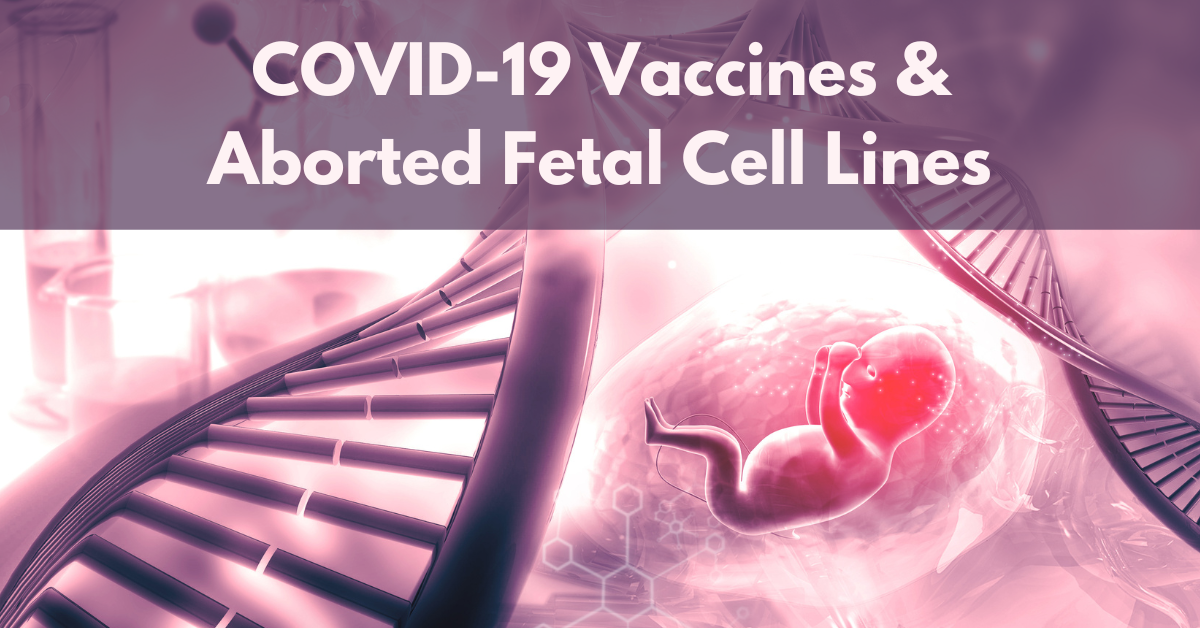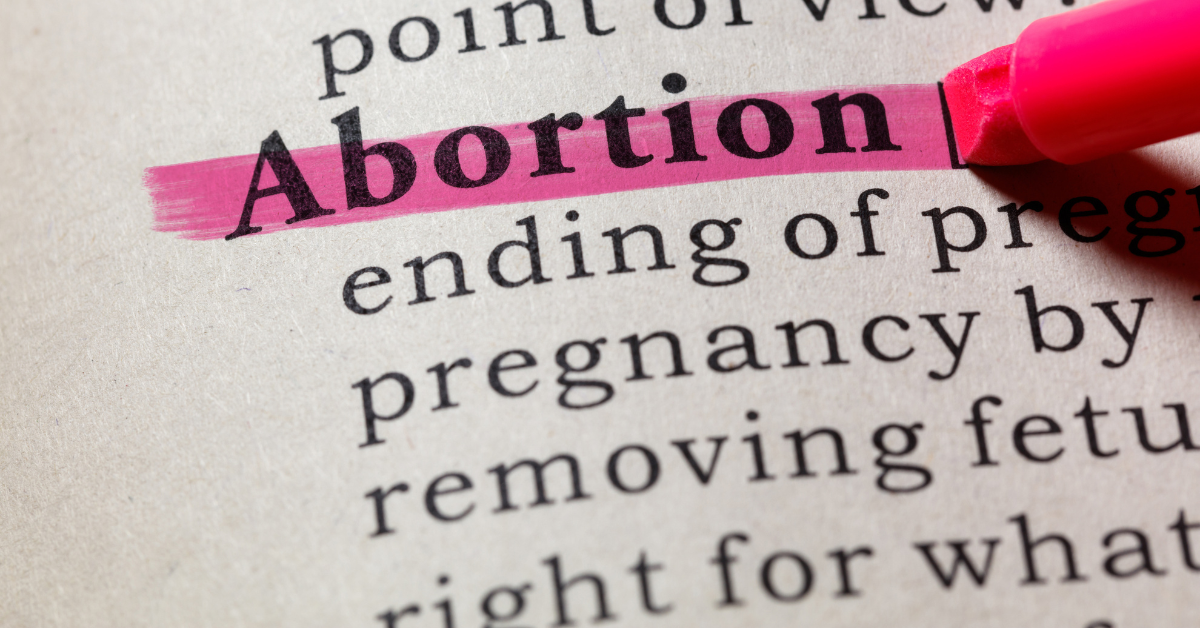
*11.14.21 click here for a full update to this article.
*Post updated 1.12.21 and 1.26.21. See footnotes.
A lot has changed in the last couple of months, and our lives look drastically different than they did when we began 2020. Words like “COVID-19” that didn’t even exist a few months ago now dominate our news cycles 24/7. Previously foreign concepts like social distancing and stay-at-home orders are now part of our “new normal.”
While I don’t want to add to the 24/7 COVID-19 bombardment, I do want to make you aware of how COVID-19 and aborted fetal cell lines intersect.
With COVID-19 spreading around the globe and urgent calls for a vaccine, there is a race to bring the first COVID-19 vaccine to market. Many companies and academic institutions have joined the race, which is being fast-tracked by skipping important phases of testing.
There are many COVID-19 vaccines in development that are being tracked by the WHO, including the front runners. Like me, those who are disturbed by the use of human fetal cell lines in vaccines will want to know about the 5 COVID-19 vaccines in development that are using human fetal cell lines. Several of these are front runners in phase 1 or phase 2 clinical trials, and one is aiming to be completed as early as September!
5 COVID-19 vaccines using human fetal cell lines
- Moderna/National Institute of Allergy and Infectious Diseases (NIAID). This US company is utilizing a new mRNA vaccine technology that has not yet been approved for market. According to a Science magazine article, the spike (S) protein used in the research and development of the vaccine is made with the HEK-293 human fetal cell line. Moderna is in phase 1 trials according to the WHO update on April 11, 2020.
*12.20.20 correction: The spike protein made using HEK-293 was used during Moderna’s research for its COVID-19 vaccine, but is NOT in the final vaccine product.
*1.26.20 note: Please see footnote for a more detailed explanation of the use of HEK-293 in the research and development of the modified spike protein Moderna used to encode its mRNA vaccine. - CanSino Biologics/Beijing Institute of Biotechnology. These two Chinese companies are developing an adenovirus-based vaccine using the HEK-293 human fetal cell line. CanSino was approved to begin phase 1 clinical trials on March 17, 2020, and are in phase 2 trials according to the WHO update on April 11, 2020.
- AstraZeneca/The University of Oxford/Jenner Institute. This collaborative effort on a COVID-19 vaccine is also using the HEK-293 human fetal cell line. Human trials will begin soon.
- Janssen Pharmaceutical Companies (owned by Johnson and Johnson). This US company uses the PER.C6 human fetal cell line for its vaccine, and was in preclinical trials according to the WHO update on April 11, 2020. Johnson & Johnson received a $456 million contract from the US Health and Human Services Office of the Assistant Secretary for Preparedness and Response (ASPR) on March 27, 2020.
- University of Pittsburgh. This US academic institution is developing its vaccine based on the HEK-293 human fetal cell line. This vaccine is being developed around the use of a unique microneedle delivery system, which is 400 tiny needles on a Velcro-like patch. Human trials will begin soon.
History of HEK-293 & PER.C6 fetal cell lines
- HEK-293 human fetal cell line (HEK = Human Embryonic Kidney) was derived from a human fetus aborted in the Netherlands in the early 1970s. The kidney tissue cultures were collected by Dr. Alex van der Eb in 1972, and then used to develop the HEK-293 fetal cell line by Dr. Frank Graham in 1973. According to Dr. Alex van der Eb, the abortion was “probably” done in 1972. The history of HEK-293 was not documented according to van der Eb who said, “We had no donor information on 293 or what was available got lost.”
- PER.C6 human fetal cell line was developed in 1985/1995 from the retinal tissue of an aborted fetus at 18 weeks gestation. The retinal cultures were taken by Dr. Alex van der Eb in 1985, but it wasn’t until 1995 that the PER.C6 cell line using those cultures was developed by Dr. Ron Bout and Dr. Frits Fallaux. According to Crucell (now part of Janssen Pharmaceutical), maker of PER.C6, “PER.C6® technology supports the growth of a wide variety of human disease-causing viruses that can subsequently be processed into vaccines. It can be used for the manufacturing of inactivated whole virus, live-attenuated, live-vector, split and subunit vaccines. PER.C6® technology also allows for efficient production of recombinant vaccines.”
Can a safe COVID-19 vaccine be developed?
Compared to normal pharmaceutical drugs, vaccines (classified as biologics) are already fast tracked. But now we’re experiencing the COVID-19 super fast track, which is skipping critical testing phases.
With many known strains of coronaviruses, vaccines have been attempted in the past but proved notoriously difficult to successfully develop. In fact, Dr. Peter Hotez (who worked on a SARS coronavirus vaccine in 2003) said the coronavirus vaccines carry “a risk of immune enhancement” – which means when animals were exposed to a coronavirus after vaccination, they had a more exaggerated reaction to the virus (even death) compared to unvaccinated animals. Hotez went on to say, “The way you reduce that risk is first you show it does not occur in laboratory animals.” The animal testing phase of coronavirus vaccines is shown to be critical, yet this phase was completely skipped by Moderna.
Hotez’s experience with developing coronavirus vaccines gives him unique first-hand knowledge of the risks of accelerating the COVID-19 vaccine development timeline. Hotez “understand(s) the importance of accelerating timelines for vaccines in general,” but said, “from everything I know, this is not the vaccine to be doing it with.”
In addition to these deep concerns, we know human fetal cell lines pose safety risks and can cause insertional mutagenesis, autoimmunity and cancer.
These COVID-19 vaccines are extremely concerning to say the least. Both the fast-tracked development & testing and the use of aborted fetal cell lines pose serious risks.
Please remain watchful and well-informed during these unprecedented times.
*Note: The information presented in this post is accurate as of April 23, 2020. However, the landscape is changing rapidly, so updates will be provided as they come.
*1.12.21 General Update: There are now many more COVID-19 vaccines using aborted fetal cell lines either in the production of the vaccine itself or in the research, development, or testing. These include the Pfizer/BioNTech and Moderna vaccines already in use under the FDA’s Emergency Use Authorization (EAU) AND vaccines still in development. For a complete list of these vaccines, please refer to the Charlotte Lozier Institute.
*1.26.21 Moderna Update: There is some confusion around the use of HEK-293 aborted fetal cell line during the research and development of Moderna’s COVID-19 vaccine. Moderna’s mRNA vaccine encodes for “a prefusion stabilized form of the Spike (S) protein, which was selected by Moderna in collaboration with investigators at the NIAID Vaccine Research Center (VRC).” This means Moderna and NIAID created a new and modified spike protein that is more stable than the spike protein found in SARS-CoV-2. This NIH article specifically states that 1) “NIAID scientists designed the stabilized spike antigen” and 2) NIAID is working with Moderna to develop its “messenger RNA (mRNA) vaccine, which directs the body’s cells to express the spike in its prefusion conformation to elicit an immune response.” This Science magazine article detailing the creation of the modified spike protein used by Moderna states “Plasmids encoding the heavy and light chains of S230, 80R and m396 IgG were transiently transfected into Expi293 cells (Thermo Fisher) using polyethylenimine.” Expi293 cells refers to the HEK-293 aborted fetal cell line. The scientific evidence shows Moderna used HEK-293 fetal cell line in the research and development of its COVID-19 vaccine which led to the production of its vaccine, mRNA-1273, which is now being widely used. The new, stabilized spike protein was used for the encoding of the mRNA vaccine. Even though HEK-293 fetal cell line was not used in the final product, some people of faith find it deeply troubling that it was used in R&D at all.
*1.26.21 Correction: An earlier version of this post incorrectly referenced a Lancet article in the section about Moderna. The article was intended to be referenced in bullet point 5 about the vaccine microneedle delivery system.















